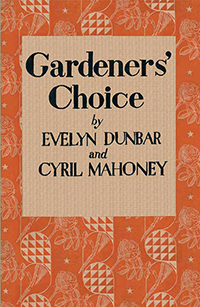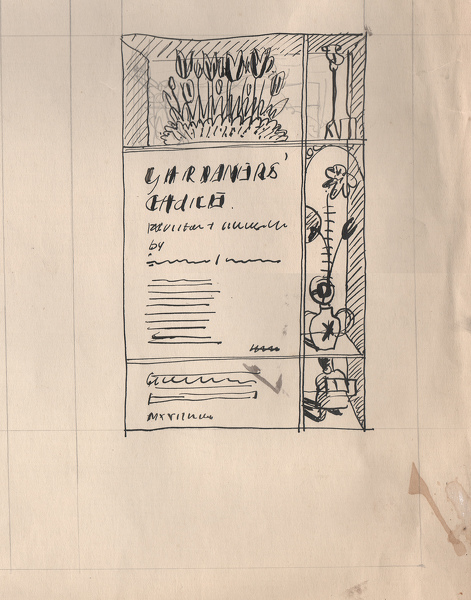
Gardeners’ Choice"Following the completion of the Brockley murals Evelyn Dunbar looked for ways to
earn some money, and was fortunate to be asked by Catherine Carswell, a Hampstead
neighbour, to illustrate her and her husband’s book The Scots Week-End and Caledonian
Vade-Mecum for Host, Guest and Wayfarer, inspired by Francis Meynell’s The Week-
End Book. Following its publication by Routledge in the summer of 1936 she asked
one of the partners, Mr Ragg, whether the firm had anything horticultural she could
illustrate: his reply was negative unless ‘you can suggest someone who could write
something really new on gardening.’ She passed this on to Charles Mahoney with
the comment ‘Now mate what about it.’ (quoted Gill Clarke, p.54) Thus the seeds of
Gardeners’ Choice were sown.
Although her earlier children’s book illustrations tended to be soapily pretty in a
Margaret Tarrantish manner, for The Scots Week-End Book she honed a more incisive
style of black pen and ink drawing, refining this further for Gardeners’ Choice to create
illustrations reminiscent of those in early herbals or eighteenth century chapbooks.
That up to this stage she did not have a clearly defined style is born out by her wash
illustration for Wuthering Heights (CAT 129) commissioned for an article by Kenneth
Clark in the November 1936 issue of Signature, which, like some of Paul Nash’s early
work, is in a distinctly pre-raphaelite manner. However for Gardeners’ Choice she
reverted exclusively to pen and ink.
The division of labour between Dunbar and Mahoney in Gardeners’ Choice is to all
intents and purpose indistinguishable. The introductory chapter, ‘Community of Plants’,
demonstrates their close collaboration: ‘In this book we present a small selection of plants which our practical knowledge of gardening and our personal outlook have led us to make.
In addition to our natural pleasure in beautiful plants and our experience in raising and
cultivating them, we have gained a close intimacy through drawing and painting them.
We have observed them as artists as well as gardeners, and have necessarily been
made aware not only of the garden value of a plant and the intrinsic beauty of its flower, but of proportions, forms and contrasts, of the subtle relations of the leaf to the bloom, or the plant to its neighbour. These observations have bred in us an animate point of view which is the inspiration of our experimental gardening and the basis of our writing.’
This fusion of authorship applies as much to drawings as to text. Gill Clarke in her 2006 book, Evelyn Dunbar: War and Country, suggested that Dunbar did the vignettes with Mahoney ‘drawing the main large plates’, (GC p.58) but with the evidence before us in this exhibition of Dunbar’s drawings of the cyclamen, eryngiums and snake’s head
fritillary (CAT 45, 42, 43) – respectively reproduced on pages 55, 81 and 89 in Gardeners’ Choice – such a distinction no longer holds good.
Looking at the ten studies of Gladiolus tristis presented here (CAT 46-55) it is instructive to note how obsessively Dunbar drew and redrew each plate to achieve the clarity and precision she and Mahoney were seeking. It is also interesting to realise that, despite such claims in ‘Community of Plants’ (p.7) as: With one of us Hieraceum aurantiacum... has behaved most meekly for years... With the other it has shown signs of becoming a menace to a small garden’, Mahoney did not have a garden of his own until he and his brother bought Oak Cottage at Wrotham in 1937, the year Gardeners’ Choice was published. It is possible that he grew some plants in his mother’s small back garden at Anerley on the Kentish-London border but most of the plants discussed were probably grown at The Cedars, and in the sheet of sketches (CAT 56-58) we get several vignettes of Mahoney seated in the garden there drawing diligently.."
Peyton Skipwith


